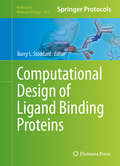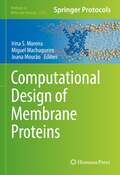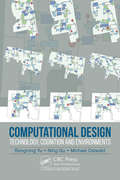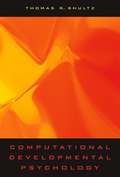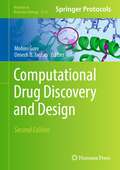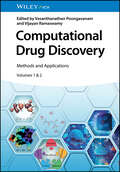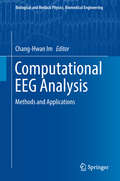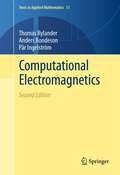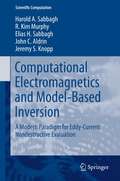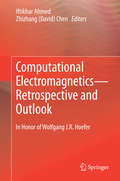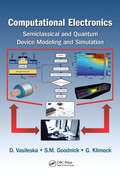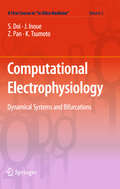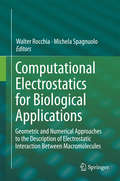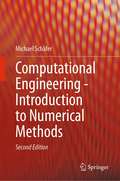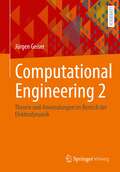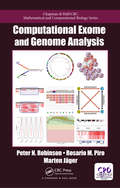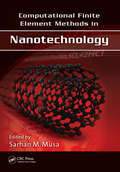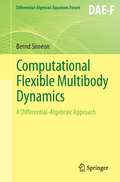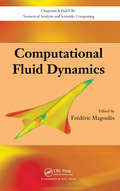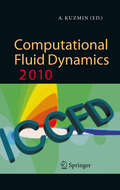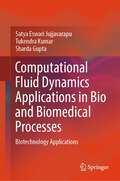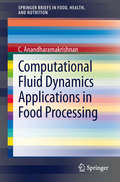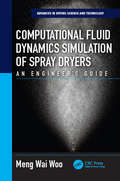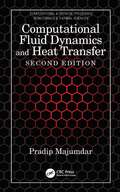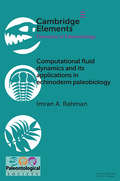- Table View
- List View
Computational Design of Ligand Binding Proteins (Methods in Molecular Biology #1414)
by Barry L. StoddardThis volume provides acollection of protocols and approaches for the creation of novel ligand bindingproteins, compiled and described by many of today's leaders in the field ofprotein engineering. Chapters focus on modeling protein ligand bindingsites, accurate modeling of protein-ligand conformational sampling, scoring ofindividual docked solutions, structure-based design program such as ROSETTA,protein engineering, and additional methodological approaches. Examples of applicationsinclude the design of metal-binding proteins and light-induced ligand bindingproteins, the creation of binding proteins that also display catalyticactivity, and the binding of larger peptide, protein, DNA and RNAligands. Written in the highly successful Methods in MolecularBiology series format, chapters include introductions to theirrespective topics, lists of the necessary materials and reagents, step-by-step,readily reproducible laboratory protocols, and tips on troubleshooting and avoidingknown pitfalls.
Computational Design of Membrane Proteins (Methods in Molecular Biology #2315)
by Irina S. Moreira Miguel Machuqueiro Joana MourãoThis volume provides an overview of the current successes as well as pitfalls and caveats that are hindering the design of membrane proteins. Divided into six parts, chapters detail membrane transporter, FoldX force field, protein stability, G-Protein Coupled Receptors (GPCR) structures, transmembrane helices, membrane molecular dynamics (MD) simulations, pH-dependent protonation states, membrane permeability, and passive transport. Written in the highly successful Methods in Molecular Biology series format, chapters include introductions to their respective topics, lists of the necessary materials and reagents, step-by-step, readily reproducible laboratory protocols, and tips on troubleshooting and avoiding known pitfalls. Authoritative and cutting-edge, Computational Design of Membrane Proteins aims to ensure successful results in the further study of this vital field.
Computational Design: Technology, Cognition and Environments
by Michael J. Ostwald Ning Gu Rongrong YuNew computational design tools have evolved rapidly and been increasingly applied in the field of design in recent years, complimenting and even replacing the traditional design media and approaches. Design as both the process and product are changing due to the emergence and adoption of these new technologies. Understanding and assessing the impact of these new computational design environments on design and designers is important for advancing design in the contemporary context. Do these new computational environments support or hinder design creativity? How do those tools facilitate designers’ thinking? Such knowledge is also important for the future development of design technologies. Research shows that design is never a mysterious non-understandable process, for example, one general view is that design process shares a common analysis-synthesis-evaluation model, during which designers interact between design problem and solution spaces. Understanding designers’ thinking in different environments is the key to design research, education and practice. This book focuses on emerging computational design environments, whose impact on design and designers have not been comprehensively and systematically studied. It comprises three parts. The history and recent developments of computational design technologies are introduced in Part I. The main categories of technologies cover from computer-aided drafting and modelling tools, to visual programming and scripting tools for algorithmic design, to advanced interfaces and platforms for interactions between designers, between designers and computers, and between the virtual environment and the physical reality. To critically explore design thinking, especially in these new computational design environments, formal approaches to studying design thinking and design cognition are introduced and compared in Part II, drawing on literature and studies from the 70s to the current era. Part III concludes the book by exploring the impact of different computational design technologies on design and designers, using a series of case studies conducted by the author team building on their close collaboration over the past five years. The book offers new insights into designers’ thinking in the rapidly evolving computational design environments, which have not been critically and systematically studied and reported in the current literature. The book is meant for design researchers, educators and students, professional practitioners and consultants, as well as people who are interested in computational design in general.
Computational Developmental Psychology
by Thomas R. ShultzAn overview of the emerging discipline of computational developmental psychology, emphasizing the use of constructivist neural networks.
Computational Drug Discovery and Design (Methods in Molecular Biology #2714)
by Mohini Gore Umesh B. JagtapThis second edition provides new and updated methods and techniques for identification of drug target, binding sites prediction, high- throughput virtual screening, lead discovery and optimization, conformational sampling, prediction of pharmacokinetic properties using computer-based methodologies. Chapters also focus on the application of the latest artificial intelligence technologies for computer aided drug discovery. Written in the format of the highly successful Methods in Molecular Biology series, each chapter includes an introduction to the topic, lists necessary methods, includes tips on troubleshooting and known pitfalls, and step-by-step, readily reproducible protocols. Authoritative and cutting-edge, Computational Drug Discovery and Design, Second Edition aims to effectively utilize computational methodologies in discovery and design of novel drugs.
Computational Drug Discovery: Methods and Applications
by Vasanthanathan Poongavanam Vijayan RamaswamyComputational Drug Discovery A comprehensive resource that explains a wide array of computational technologies and methods driving innovation in drug discovery Computational Drug Discovery: Methods and Applications (2 volume set) covers a wide range of cutting-edge computational technologies and computational chemistry methods that are transforming drug discovery. The book delves into recent advances, particularly focusing on artificial intelligence (AI) and its application for protein structure prediction, AI-enabled virtual screening, and generative modeling for compound design. Additionally, it covers key technological advancements in computing such as quantum and cloud computing that are driving innovations in drug discovery. Furthermore, dedicated chapters that addresses the recent trends in the field of computer aided drug design, including ultra-large-scale virtual screening for hit identification, computational strategies for designing new therapeutic modalities like PROTACs and covalent inhibitors that target residues beyond cysteine are also presented. To offer the most up-to-date information on computational methods utilized in computational drug discovery, it covers chapters highlighting the use of molecular dynamics and other related methods, application of QM and QM/MM methods in computational drug design, and techniques for navigating and visualizing the chemical space, as well as leveraging big data to drive drug discovery efforts. The book is thoughtfully organized into eight thematic sections, each focusing on a specific computational method or technology applied to drug discovery. Authored by renowned experts from academia, pharmaceutical industry, and major drug discovery software providers, it offers an overview of the latest advances in computational drug discovery. Key topics covered in the book include: Application of molecular dynamics simulations and related approaches in drug discovery The application of QM, hybrid approaches such as QM/MM, and fragment molecular orbital framework for understanding protein-ligand interactions Adoption of artificial intelligence in pre-clinical drug discovery, encompassing protein structure prediction, generative modeling for de novo design, and virtual screening. Techniques for navigating and visualizing the chemical space, along with harnessing big data to drive drug discovery efforts. Methods for performing ultra-large-scale virtual screening for hit identification. Computational strategies for designing new therapeutic models, including PROTACs and molecular glues. In silico ADMET approaches for predicting a variety of pharmacokinetic and physicochemical endpoints. The role of computing technologies like quantum computing and cloud computing in accelerating drug discovery This book will provide readers an overview of the latest advancements in computational drug discovery and serve as a valuable resource for professionals engaged in drug discovery.
Computational EEG Analysis: Methods and Applications (Biological and Medical Physics, Biomedical Engineering)
by Chang-Hwan ImThis book introduces and reviews all of the currently available methods being used for computational electroencephalogram (EEG) analysis, from the fundamentals through to the state-of-the-art. The aim of the book is to help biomedical engineers and medical doctors who use EEG to better understand the methods and applications of computational EEG analysis from a single, well-organized resource. Following a brief introduction to the principles of EEG and acquisition techniques, the book is divided into two main sections. The first of these covers analysis methods, beginning with preprocessing, and then describing EEG spectral analysis, event-related potential analysis, source imaging and multimodal neuroimaging, and functional connectivity analysis. The following section covers application of EEG analysis to specific fields, including the diagnosis of psychiatric diseases and neurological disorders, brain-computer interfacing, and social neuroscience. Aimed at practicing medical specialists, engineers, researchers and advanced students, the book features contributions from world-renowned biomedical engineers working across a broad spectrum of computational EEG analysis techniques and EEG applications.
Computational Electromagnetics (Texts in Applied Mathematics #51)
by Thomas Rylander Par Ingelström Anders BondesonComputational Electromagnetics is a young and growing discipline, expanding as a result of the steadily increasing demand for software for the design and analysis of electrical devices. This book introduces three of the most popular numerical methods for simulating electromagnetic fields: the finite difference method, the finite element method and the method of moments. In particular it focuses on how these methods are used to obtain valid approximations to the solutions of Maxwell's equations, using, for example, "staggered grids" and "edge elements. " The main goal of the book is to make the reader aware of different sources of errors in numerical computations, and also to provide the tools for assessing the accuracy of numerical methods and their solutions. To reach this goal, convergence analysis, extrapolation, von Neumann stability analysis, and dispersion analysis are introduced and used frequently throughout the book. Another major goal of the book is to provide students with enough practical understanding of the methods so they are able to write simple programs on their own. To achieve this, the book contains several MATLAB programs and detailed description of practical issues such as assembly of finite element matrices and handling of unstructured meshes. Finally, the book aims at making the students well-aware of the strengths and weaknesses of the different methods, so they can decide which method is best for each problem. In this second edition, extensive computer projects are added as well as new material throughout. Reviews of previous edition: "The well-written monograph is devoted to students at the undergraduate level, but is also useful for practising engineers. " (Zentralblatt MATH, 2007)
Computational Electromagnetics and Model-Based Inversion: A Modern Paradigm for Eddy-Current Nondestructive Evaluation (Scientific Computation)
by Elias H. Sabbagh Harold A Sabbagh Jeremy S Knopp John C. Aldrin R. Kim MurphyThis volume will define the direction of eddy-current technology in nondestructive evaluation (NDE) in the twenty-first century. It describes the natural marriage of the computer to eddy-current NDE, and its publication was encouraged by favorable responses from workers in the nuclear-power and aerospace industries. It will be used by advanced students and practitioners in the fields of computational electromagnetics, electromagnetic inverse-scattering theory, nondestructive evaluation, materials evaluation and biomedical imaging, among others, and will be based on our experience in applying the subject of computational electromagnetics to these areas, as manifested by our recent research and publications. Finally, it will be a reference to future monographs on advanced NDE that are being contemplated by our colleagues and others. Its importance lies in the fact that it will be the first book to show that advanced computational methods can be used to solve practical, but difficult, problems in eddy-current NDE. In fact, in many cases these methods are the only things available for solving the problems. The book will cover the topic of computational electromagnetics in eddy-current nondestructive evaluation (NDE) by emphasizing three distinct topics: (a) fundamental mathematical principles of volume-integral equations as a subset of computational electromagnetics, (b) mathematical algorithms applied to signal-processing and inverse scattering problems, and (c) applications of these two topics to problems in which real and model data are used. This will make the book more than an academic exercise; we expect it to be valuable to users of eddy-current NDE technology in industries as varied as nuclear power, aerospace, materials characterization and biomedical imaging. We know of no other book on the market that covers this material in the manner in which we will present it, nor are there any books, to our knowledge, that apply this material to actual test situations that are of importance to the industries cited. It will be the first book to actually define the modern technology of eddy-current NDE, by showing how mathematics and the computer will solve problems more effectively than current analog practice.
Computational Electromagnetics--Retrospective and Outlook: In Honor of Wolfgang J.R. Hoefer
by Iftikhar Ahmed Zhizhang David ChenThe book will cover the past, present and future developments of field theory and computational electromagnetics. The first two chapters will give an overview of the historical developments and the present the state-of-the-art in computational electromagnetics. These two chapters will set the stage for discussing recent progress, new developments, challenges, trends and major directions in computational electromagnetics with three main emphases: a. Modeling of ever larger structures with multi-scale dimensions and multi-level descriptions (behavioral, circuit, network and field levels) and transient behaviours b. Inclusions of physical effects other than electromagnetic: quantum effects, thermal effects, mechanical effects and nano scale features c. New developments in available computer hardware, programming paradigms (MPI, Open MP, CUDA and Open CL) and the associated new modeling approaches These are the current emerging topics in the area of computational electromagnetics and may provide readers a comprehensive overview of future trends and directions in the area. The book is written for students, research scientists, professors, design engineers and consultants who engaged in the fields of design, analysis and research of the emerging technologies related to computational electromagnetics, RF/microwave, optimization, new numerical methods, as well as accelerator simulator, dispersive materials, nano-antennas, nano-waveguide, nano-electronics, terahertz applications, bio-medical and material sciences. The book may also be used for those involved in commercializing electromagnetic and related emerging technologies, sensors and the semiconductor industry. The book can be used as a reference book for graduates and post graduates. It can also be used as a text book for workshops and continuing education for researchers and design engineers.
Computational Electronics: Semiclassical and Quantum Device Modeling and Simulation
by Stephen M. Goodnick Dragica Vasileska Gerhard Klimeck<p>Starting with the simplest semiclassical approaches and ending with the description of complex fully quantum-mechanical methods for quantum transport analysis of state-of-the-art devices, Computational Electronics: Semiclassical and Quantum Device Modeling and Simulation provides a comprehensive overview of the essential techniques and methods for effectively analyzing transport in semiconductor devices. <p>With the transistor reaching its limits and new device designs and paradigms of operation being explored, this timely resource delivers the simulation methods needed to properly model state-of-the-art nanoscale devices. The first part examines semiclassical transport methods, including drift-diffusion, hydrodynamic, and Monte Carlo methods for solving the Boltzmann transport equation. Details regarding numerical implementation and sample codes are provided as templates for sophisticated simulation software. <p>The second part introduces the density gradient method, quantum hydrodynamics, and the concept of effective potentials used to account for quantum-mechanical space quantization effects in particle-based simulators. Highlighting the need for quantum transport approaches, it describes various quantum effects that appear in current and future devices being mass-produced or fabricated as a proof of concept. In this context, it introduces the concept of effective potential used to approximately include quantum-mechanical space-quantization effects within the semiclassical particle-based device simulation scheme. <p>Addressing the practical aspects of computational electronics, this authoritative resource concludes by addressing some of the open questions related to quantum transport not covered in most books. Complete with self-study problems and numerous examples throughout, this book supplies readers with the practical understanding required to create their own simulators.</p>
Computational Electrophysiology: Dynamical Systems And Bifurcations (A First Course in “In Silico Medicine” #2)
by Masao Tanaka Zhenxing Pan Junko Inoue Shinji Doi Kunichika TsumotoBiological systems inherently possess much ambiguity or uncertainty. Computational electrophysiology is the one area, from among the vast and rapidly growing discipline of computational and systems biology, in which computational or mathematical models have succeeded. This textbook provides a practical and quick guide to both computational electrophysiology and numerical bifurcation analysis. Bifurcation analysis is a very powerful tool for the analysis of such highly nonlinear biological systems. Bifurcation theory provides a way to analyze the effect of a parameter change on a system and to detect a critical parameter value when the qualitative nature of the system changes. Included in this work are many examples of numerical computations of bifurcation analysis of various models as well as mathematical models with different abstraction levels from neuroscience and electrophysiology. This volume will benefit graduate and undergraduate students as well as researchers in diverse fields of science.
Computational Electrostatics for Biological Applications: Geometric and Numerical Approaches to the Description of Electrostatic Interaction Between Macromolecules
by Walter Rocchia Michela SpagnuoloThis book presents established and new approaches to perform calculations of electrostatic interactions at the nanoscale, with particular focus on molecular biology applications. It is based on the proceedings of the Computational Electrostatics for Biological Applications international meeting, which brought together researchers in computational disciplines to discuss and explore diverse methods to improve electrostatic calculations. Fostering an interdisciplinary approach to the description of complex physical and biological problems, this book encompasses contributions originating in the fields of geometry processing, shape modeling, applied mathematics, and computational biology and chemistry. The main topics covered are theoretical and numerical aspects of the solution of the Poisson-Boltzmann equation, surveys and comparison among geometric approaches to the modelling of molecular surfaces and related discretization and computational issues. It also includes a number of contributions addressing applications in biology, biophysics and nanotechnology. The book is primarily intended as a reference for researchers in the computational molecular biology and chemistry fields. As such, it also aims at becoming a key source of information for a wide range of scientists who need to know how modeling and computing at the molecular level may influence the design and interpretation of their experiments.
Computational Engineering - Introduction to Numerical Methods
by Michael SchäferNumerical simulation methods in all engineering disciplines gains more and more importance.The successful and efficient application of such tools requires certain basic knowledge about the underlying numerical techniques.The text gives a practice-oriented introduction in modern numerical methods as they typically are applied in mechanical, chemical, or civil engineering. Problems from heat transfer, structural mechanics, and fluid mechanics constitute a thematical focus of the text.For the basic understanding of the topic aspects of numerical mathematics, natural sciences, computer science, and the corresponding engineering area are simultaneously important. Usually, the necessary information is distributed in different textbooks from the individual disciplines. In the present text the subject matter is presented in a comprehensive multidisciplinary way, where aspects from the different fields are treated insofar as it is necessary for general understanding. Overarching aspects and important questions related to accuracy, efficiency, and cost effectiveness are discussed.The topics are presented in an introductory manner, such that besides basic mathematical standard knowledge in analysis and linear algebra no further prerequisites are necessary. The book is suitable either for self-study or as an accompanying textbook for corresponding lectures. It can be useful for students of engineering disciplines as well as for computational engineers in industrial practice.
Computational Engineering 2: Theorie und Anwendungen im Bereich der Elektrodynamik
by Jürgen GeiserDas Buch zeigt Theorie und praktische Anwendungen im Bereich des Computational Engineering (berechnendes Ingenieurwesen) für elektrodynamische Anwendungen. Es illustriert sowohl die mathematischen Modelle wie auch die zugehörigen Simulationsmethoden für die verschiedenen Ingenieursanwendungen. Außerdem präsentiert es Strategien zur Verbesserung der numerischen Methoden wie z. B. Zeit-Raum-Verfahren, hyperbolische Löser, Multiskalenlöser oder strukturerhaltende Verfahren sowie Kopplungsverfahren für elektrodynamische und hydrodynamische Modelle auf verschiedenen Zeit- und Raumskalen. Dabei werden Ansätze zur Zerlegung in einfachere und effizient lösbare Teilprobleme vorgestellt. Gerade im Bereich der Multikomponenten- und Multiskalenmodelle bei komplizierten Ingenieursproblemen sind solche neuartigen Multiskalenverfahren wichtig. Weiter werden auch stochastische Modelle im Bereich der Partikelmodelle und deren Einbindung in deterministische Modelle besprochen. Diese neueren Problemstellungen brauchen iterative Löser zur Kopplung der verschiedenen Zeit- und Raumskalen. Die umfangreichen Beispiele aus dem Bereich der Elektrodynamik (inkl. elektromagnetische Felder, Antennenmodelle, Teilchenmodelle im Bereich der Plasmasimulation) geben dem Leser einen Überblick zu den aktuellen Themen und deren praktischer Umsetzung in spätere Simulationsprogramme.
Computational Exome and Genome Analysis (Chapman & Hall/CRC Computational Biology Series)
by Peter N. Robinson Rosario Michael Piro Marten JagerExome and genome sequencing are revolutionizing medical research and diagnostics, but the computational analysis of the data has become an extremely heterogeneous and often challenging area of bioinformatics. <P><P> Computational Exome and Genome Analysis provides a practical introduction to all of the major areas in the field, enabling readers to develop a comprehensive understanding of the sequencing process and the entire computational analysis pipeline.
Computational Finite Element Methods in Nanotechnology
by Sarhan M. MusaComputational Finite Element Methods in Nanotechnology demonstrates the capabilities of finite element methods in nanotechnology for a range of fields. Bringing together contributions from researchers around the world, it covers key concepts as well as cutting-edge research and applications to inspire new developments and future interdisciplinary research. In particular, it emphasizes the importance of finite element methods (FEMs) for computational tools in the development of efficient nanoscale systems. The book explores a variety of topics, including: A novel FE-based thermo-electrical-mechanical-coupled model to study mechanical stress, temperature, and electric fields in nano- and microelectronics The integration of distributed element, lumped element, and system-level methods for the design, modeling, and simulation of nano- and micro-electromechanical systems (N/MEMS) Challenges in the simulation of nanorobotic systems and macro-dimensions The simulation of structures and processes such as dislocations, growth of epitaxial films, and precipitation Modeling of self-positioning nanostructures, nanocomposites, and carbon nanotubes and their composites Progress in using FEM to analyze the electric field formed in needleless electrospinning How molecular dynamic (MD) simulations can be integrated into the FEM Applications of finite element analysis in nanomaterials and systems used in medicine, dentistry, biotechnology, and other areas The book includes numerous examples and case studies, as well as recent applications of microscale and nanoscale modeling systems with FEMs using COMSOL Multiphysics® and MATLAB®. A one-stop reference for professionals, researchers, and students, this is also an accessible introduction to computational FEMs in nanotechnology for those new to the field.
Computational Flexible Multibody Dynamics: A Differential-Algebraic Approach (Differential-Algebraic Equations Forum)
by Bernd SimeonThis monograph, written from a numerical analysis perspective, aims to provide a comprehensive treatment of both the mathematical framework and the numerical methods for flexible multibody dynamics. Not only is this field permanently and rapidly growing, with various applications in aerospace engineering, biomechanics, robotics, and vehicle analysis, its foundations can also be built on reasonably established mathematical models. Regarding actual computations, great strides have been made over the last two decades, as sophisticated software packages are now capable of simulating highly complex structures with rigid and deformable components. The approach used in this book should benefit graduate students and scientists working in computational mechanics and related disciplines as well as those interested in time-dependent partial differential equations and heterogeneous problems with multiple time scales. Additionally, a number of open issues at the frontiers of research are addressed by taking a differential-algebraic approach and extending it to the notion of transient saddle point problems.
Computational Fluid Dynamics (Chapman & Hall/CRC Numerical Analysis and Scientific Computing Series)
by Frédéric MagoulèsExploring new variations of classical methods as well as recent approaches appearing in the field, Computational Fluid Dynamics demonstrates the extensive use of numerical techniques and mathematical models in fluid mechanics. It presents various numerical methods, including finite volume, finite difference, finite element, spectral, smoothed parti
Computational Fluid Dynamics 2010: Proceedings of the Sixth International Conference on Computational Fluid Dynamics, ICCFD6, St Petersburg, Russia, on July 12-16, 2010
by Alexander KuzminThe International Conference on Computational Fluid Dynamics is held every two years and brings together physicists, mathematicians and engineers to review and share recent advances in mathematical and computational techniques for modeling fluid flow. The proceedings of the 2010 conference (ICCFD6) held in St Petersburg, Russia, contain a selection of refereed contributions and are meant to serve as a source of reference for all those interested in the state of the art in computational fluid dynamics.
Computational Fluid Dynamics Applications in Bio and Biomedical Processes: Biotechnology Applications
by Satya Eswari Jujjavarapu Tukendra Kumar Sharda GuptaThis book covers emerging areas in novel design and their hydrodynamic properties relevant to bioreactors, environmental system, electrochemical systems, food processing and biomedical engineering. This book uses an interdisciplinary approach to provide a comprehensive prospective simulation modeling and hydrodynamic study in advanced biotechnological process and includes reviews of the most recent state of art in modeling and simulation of flows in biological process, such as CFD. Written by internationally recognized researchers in the field, each chapter provides a strong introductory section that is useful to both readers currently in the field and readers interested in learning more about these areas.
Computational Fluid Dynamics Applications in Food Processing (SpringerBriefs in Food, Health, and Nutrition)
by C. AnandharamakrishnanComputational Fluid Dynamics (CFD) has been applied extensively to great benefit in the food processing sector. Its numerous applications include: predicting the gas flow pattern and particle histories, such as temperature, velocity, residence time, and impact position during spray drying; modeling of ovens to provide information about temperature and airflow pattern throughout the baking chamber to enhance heat transfer and in turn final product quality; designing hybrid heating ovens, such as microwave-infrared, infrared-electrical or microwave-electrical ovens for rapid baking; model the dynamics of gastrointestinal contents during digestion based on the motor response of the GI tract and the physicochemical properties of luminal contents; retort processing of canned solid and liquid foods for understanding and optimization of the heat transfer processes. This Brief will recapitulate the various applications of CFD modeling, discuss the recent developments in this field, and identify the strengths and weaknesses of CFD when applied in the food industry.
Computational Fluid Dynamics Simulation of Spray Dryers: An Engineer’s Guide (Advances in Drying Science and Technology #Vol. 2)
by Meng Wai WooBridging the gap in understanding between the spray drying industry and the numerical modeler on spray drying, Computational Fluid Dynamics Simulation of Spray Dryers: An Engineer’s Guide shows how to numerically capture important physical phenomena within a spray drying process using the CFD technique. It includes numerical strategies to effectively describe these phenomena, which are collated from research work and CFD industrial consultation, in particular to the dairy industry. Along with showing how to set up models, the book helps readers identify the capabilities and uncertainties of the CFD technique for spray drying. After briefly covering the basics of CFD, the book discusses airflow modeling, atomization and particle tracking, droplet drying, quality modeling, agglomeration and wall deposition modeling, and simulation validation techniques. The book also answers questions related to common challenges in industrial applications.
Computational Fluid Dynamics and Heat Transfer (Series In Computational And Physical Processes In Mechanics And Thermal Sciences Ser.)
by Pradip MajumdarThis book provides a thorough understanding of fluid dynamics and heat and mass transfer. The Second Edition contains new chapters on mesh generation and computational modeling of turbulent flow. Combining theory and practice in classic problems and computer code, the text includes numerous worked-out examples. Students will be able to develop computational analysis models for complex problems more efficiently using commercial codes such as ANSYS, STAR CCM+, and COMSOL. With detailed explanations on how to implement computational methodology into computer code, students will be able to solve complex problems on their own and develop their own customized simulation models, including problems in heat transfer, mass transfer, and fluid flows. These problems are solved and illustrated in step-by-step derivations and figures. FEATURES Provides unified coverage of computational heat transfer and fluid dynamics Covers basic concepts and then applies computational methods for problem analysis and solution Covers most common higher-order time-approximation schemes Covers most common and advanced linear solvers Contains new chapters on mesh generation and computer modeling of turbulent flow Computational Fluid Dynamics and Heat Transfer, Second Edition, is valuable to engineering instructors and students taking courses in computational heat transfer and computational fluid dynamics.
Computational Fluid Dynamics and its Applications in Echinoderm Palaeobiology (Elements of Paleontology)
by Imran A. RahmanComputational fluid dynamics (CFD), which involves using computers to simulate fluid flow, is emerging as a powerful approach for elucidating the palaeobiology of ancient organisms. Here, Imran A. Rahman describes its applications for studying fossil echinoderms. When properly configured, CFD simulations can be used to test functional hypotheses in extinct species, informing on aspects such as feeding and stability. They also show great promise for addressing ecological questions related to the interaction between organisms and their environment. CFD has the potential to become an important tool in echinoderm palaeobiology over the coming years.
